Strategic Analysis of Oxfam: Competitive Advantage and Value Creation
VerifiedAdded on 2023/01/12
|12
|3660
|39
Report
AI Summary
This report provides a comprehensive analysis of Oxfam, a non-profit organization, utilizing Porter's Five Forces framework to assess its competitive environment. The analysis examines the threat of new entrants, bargaining power of suppliers and buyers, the threat of substitute products, and the intensity of rivalry among firms within the social industry. The report then delves into Oxfam's value chain, scrutinizing inbound logistics, outbound logistics, and operational activities, as well as two key support activities: human resource management and technology development. The analysis highlights Oxfam's strategies for managing its complex logistics, operational activities across various countries, and its commitment to providing various delivery options to customers. Overall, the report offers insights into Oxfam's strategic positioning and its efforts to maintain a competitive advantage in the non-profit sector, underscoring the importance of these strategies in achieving its goals of poverty reduction and disaster relief.
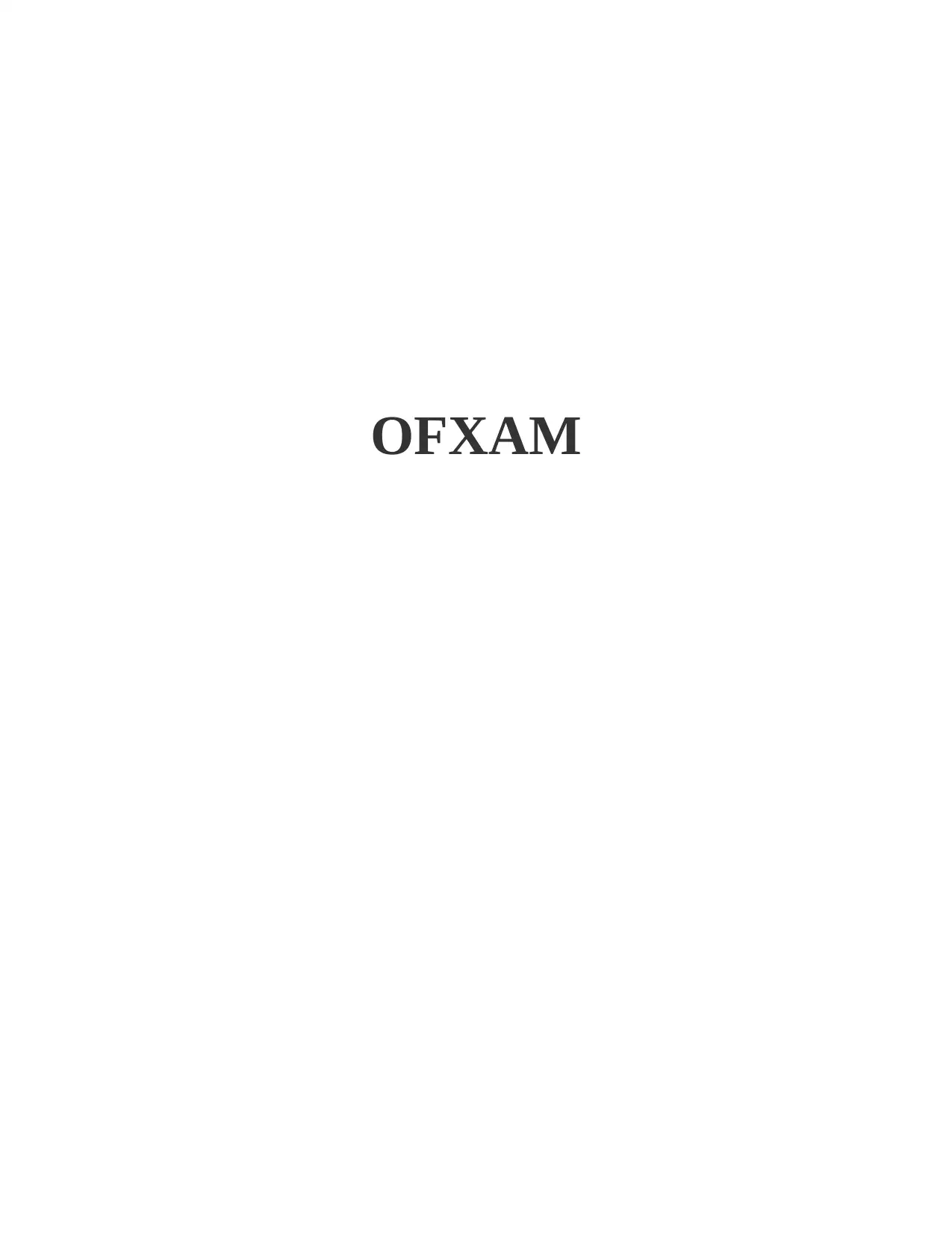
OFXAM
Paraphrase This Document
Need a fresh take? Get an instant paraphrase of this document with our AI Paraphraser
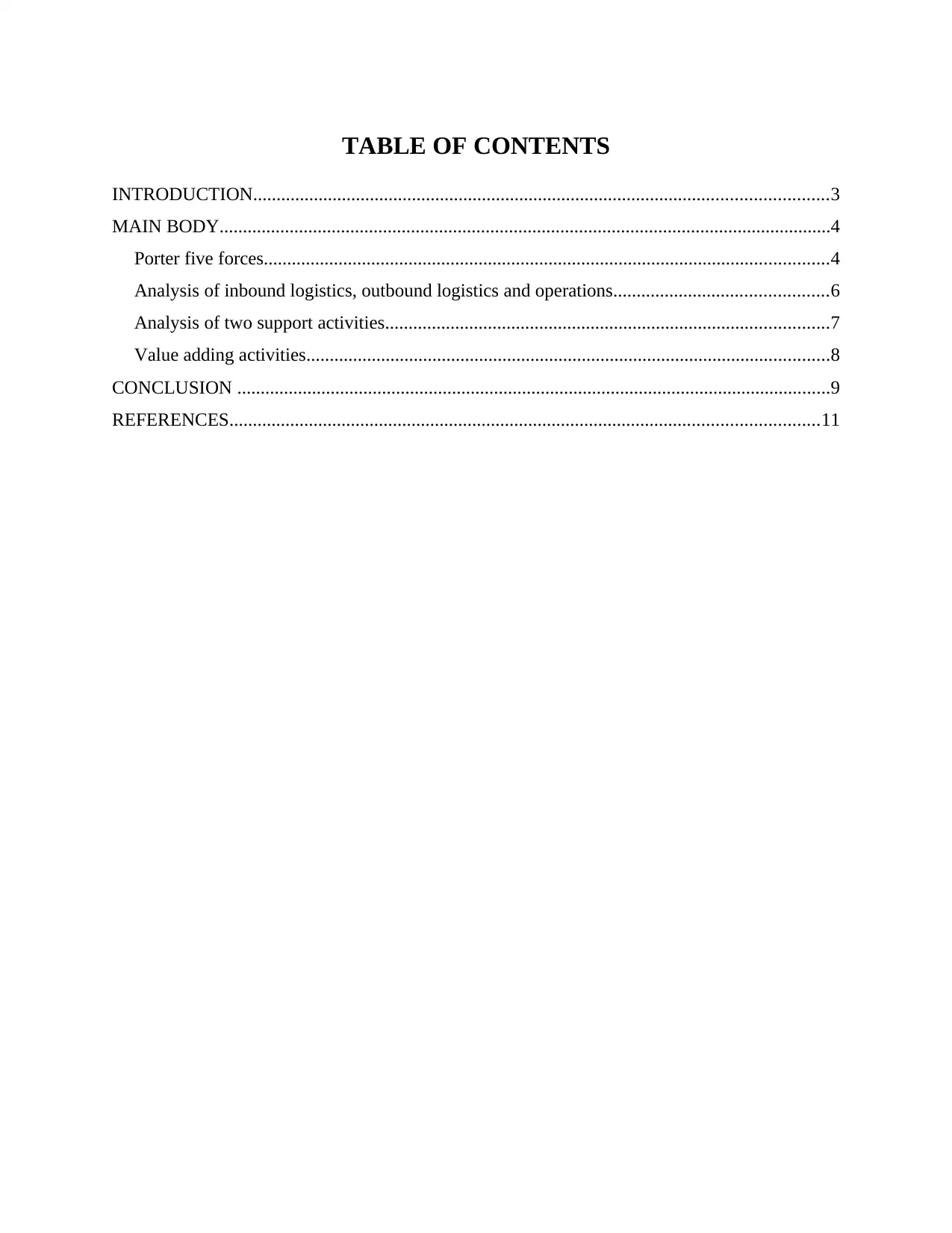
TABLE OF CONTENTS
INTRODUCTION...........................................................................................................................3
MAIN BODY...................................................................................................................................4
Porter five forces.........................................................................................................................4
Analysis of inbound logistics, outbound logistics and operations..............................................6
Analysis of two support activities...............................................................................................7
Value adding activities................................................................................................................8
CONCLUSION ...............................................................................................................................9
REFERENCES..............................................................................................................................11
INTRODUCTION...........................................................................................................................3
MAIN BODY...................................................................................................................................4
Porter five forces.........................................................................................................................4
Analysis of inbound logistics, outbound logistics and operations..............................................6
Analysis of two support activities...............................................................................................7
Value adding activities................................................................................................................8
CONCLUSION ...............................................................................................................................9
REFERENCES..............................................................................................................................11
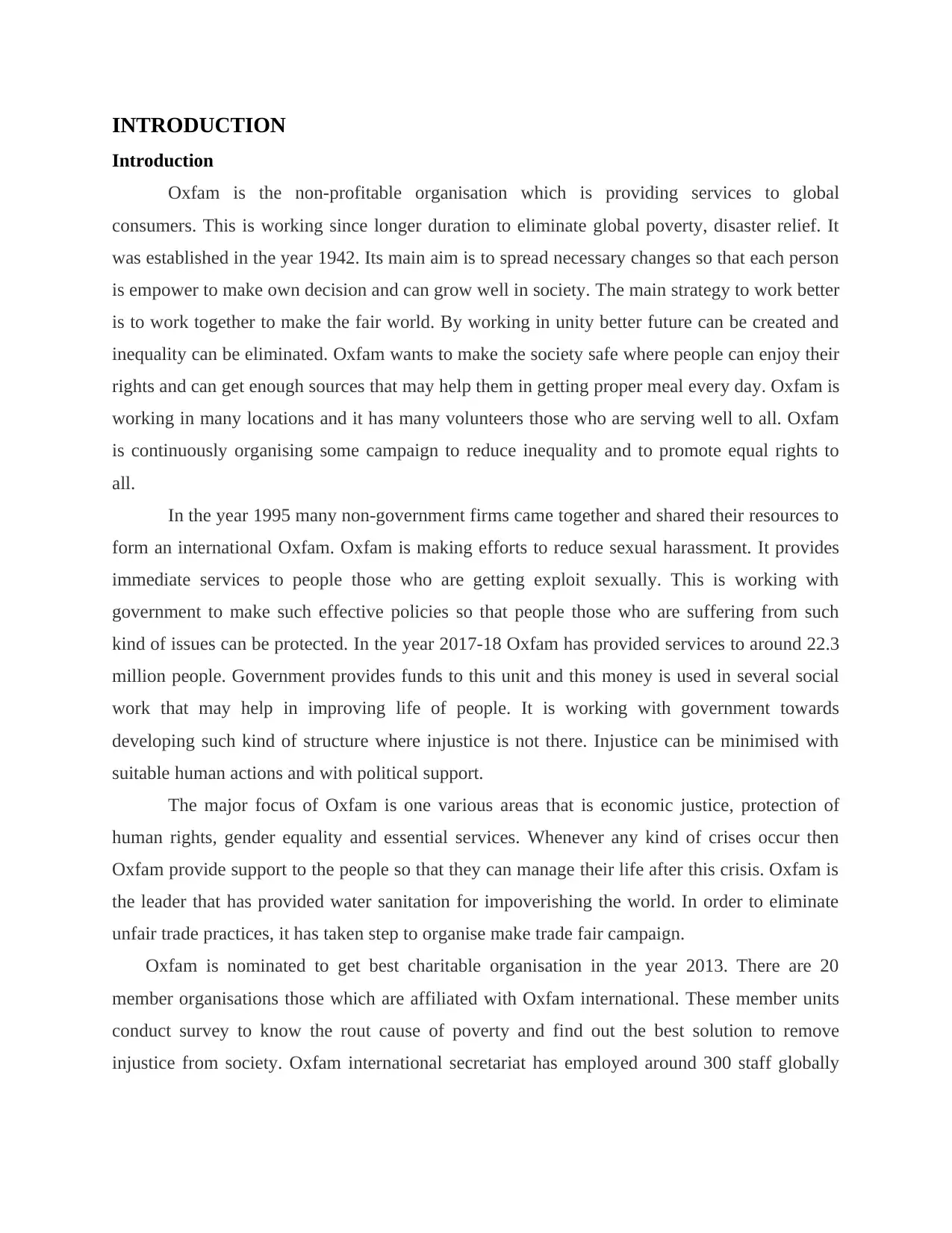
INTRODUCTION
Introduction
Oxfam is the non-profitable organisation which is providing services to global
consumers. This is working since longer duration to eliminate global poverty, disaster relief. It
was established in the year 1942. Its main aim is to spread necessary changes so that each person
is empower to make own decision and can grow well in society. The main strategy to work better
is to work together to make the fair world. By working in unity better future can be created and
inequality can be eliminated. Oxfam wants to make the society safe where people can enjoy their
rights and can get enough sources that may help them in getting proper meal every day. Oxfam is
working in many locations and it has many volunteers those who are serving well to all. Oxfam
is continuously organising some campaign to reduce inequality and to promote equal rights to
all.
In the year 1995 many non-government firms came together and shared their resources to
form an international Oxfam. Oxfam is making efforts to reduce sexual harassment. It provides
immediate services to people those who are getting exploit sexually. This is working with
government to make such effective policies so that people those who are suffering from such
kind of issues can be protected. In the year 2017-18 Oxfam has provided services to around 22.3
million people. Government provides funds to this unit and this money is used in several social
work that may help in improving life of people. It is working with government towards
developing such kind of structure where injustice is not there. Injustice can be minimised with
suitable human actions and with political support.
The major focus of Oxfam is one various areas that is economic justice, protection of
human rights, gender equality and essential services. Whenever any kind of crises occur then
Oxfam provide support to the people so that they can manage their life after this crisis. Oxfam is
the leader that has provided water sanitation for impoverishing the world. In order to eliminate
unfair trade practices, it has taken step to organise make trade fair campaign.
Oxfam is nominated to get best charitable organisation in the year 2013. There are 20
member organisations those which are affiliated with Oxfam international. These member units
conduct survey to know the rout cause of poverty and find out the best solution to remove
injustice from society. Oxfam international secretariat has employed around 300 staff globally
Introduction
Oxfam is the non-profitable organisation which is providing services to global
consumers. This is working since longer duration to eliminate global poverty, disaster relief. It
was established in the year 1942. Its main aim is to spread necessary changes so that each person
is empower to make own decision and can grow well in society. The main strategy to work better
is to work together to make the fair world. By working in unity better future can be created and
inequality can be eliminated. Oxfam wants to make the society safe where people can enjoy their
rights and can get enough sources that may help them in getting proper meal every day. Oxfam is
working in many locations and it has many volunteers those who are serving well to all. Oxfam
is continuously organising some campaign to reduce inequality and to promote equal rights to
all.
In the year 1995 many non-government firms came together and shared their resources to
form an international Oxfam. Oxfam is making efforts to reduce sexual harassment. It provides
immediate services to people those who are getting exploit sexually. This is working with
government to make such effective policies so that people those who are suffering from such
kind of issues can be protected. In the year 2017-18 Oxfam has provided services to around 22.3
million people. Government provides funds to this unit and this money is used in several social
work that may help in improving life of people. It is working with government towards
developing such kind of structure where injustice is not there. Injustice can be minimised with
suitable human actions and with political support.
The major focus of Oxfam is one various areas that is economic justice, protection of
human rights, gender equality and essential services. Whenever any kind of crises occur then
Oxfam provide support to the people so that they can manage their life after this crisis. Oxfam is
the leader that has provided water sanitation for impoverishing the world. In order to eliminate
unfair trade practices, it has taken step to organise make trade fair campaign.
Oxfam is nominated to get best charitable organisation in the year 2013. There are 20
member organisations those which are affiliated with Oxfam international. These member units
conduct survey to know the rout cause of poverty and find out the best solution to remove
injustice from society. Oxfam international secretariat has employed around 300 staff globally
⊘ This is a preview!⊘
Do you want full access?
Subscribe today to unlock all pages.

Trusted by 1+ million students worldwide
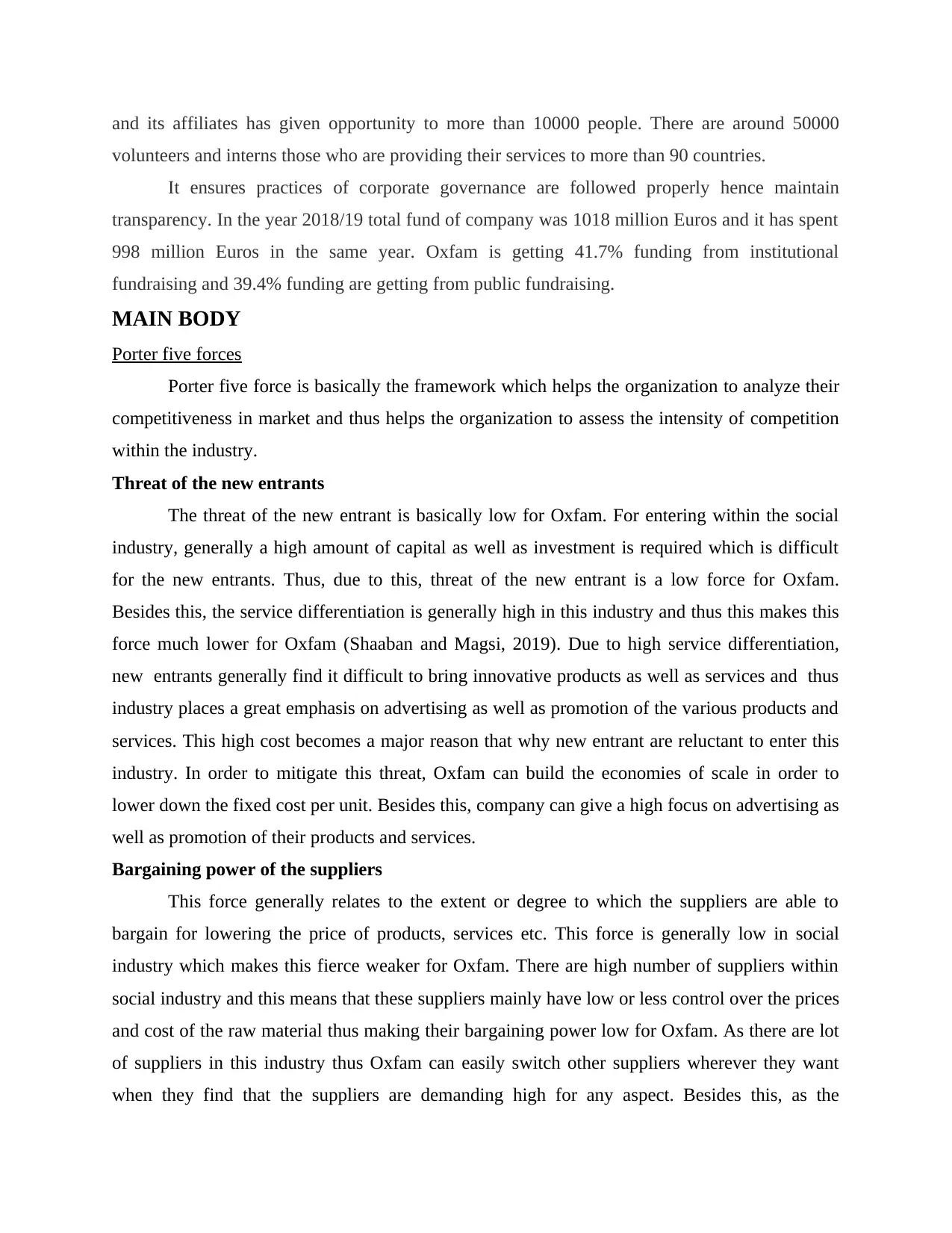
and its affiliates has given opportunity to more than 10000 people. There are around 50000
volunteers and interns those who are providing their services to more than 90 countries.
It ensures practices of corporate governance are followed properly hence maintain
transparency. In the year 2018/19 total fund of company was 1018 million Euros and it has spent
998 million Euros in the same year. Oxfam is getting 41.7% funding from institutional
fundraising and 39.4% funding are getting from public fundraising.
MAIN BODY
Porter five forces
Porter five force is basically the framework which helps the organization to analyze their
competitiveness in market and thus helps the organization to assess the intensity of competition
within the industry.
Threat of the new entrants
The threat of the new entrant is basically low for Oxfam. For entering within the social
industry, generally a high amount of capital as well as investment is required which is difficult
for the new entrants. Thus, due to this, threat of the new entrant is a low force for Oxfam.
Besides this, the service differentiation is generally high in this industry and thus this makes this
force much lower for Oxfam (Shaaban and Magsi, 2019). Due to high service differentiation,
new entrants generally find it difficult to bring innovative products as well as services and thus
industry places a great emphasis on advertising as well as promotion of the various products and
services. This high cost becomes a major reason that why new entrant are reluctant to enter this
industry. In order to mitigate this threat, Oxfam can build the economies of scale in order to
lower down the fixed cost per unit. Besides this, company can give a high focus on advertising as
well as promotion of their products and services.
Bargaining power of the suppliers
This force generally relates to the extent or degree to which the suppliers are able to
bargain for lowering the price of products, services etc. This force is generally low in social
industry which makes this fierce weaker for Oxfam. There are high number of suppliers within
social industry and this means that these suppliers mainly have low or less control over the prices
and cost of the raw material thus making their bargaining power low for Oxfam. As there are lot
of suppliers in this industry thus Oxfam can easily switch other suppliers wherever they want
when they find that the suppliers are demanding high for any aspect. Besides this, as the
volunteers and interns those who are providing their services to more than 90 countries.
It ensures practices of corporate governance are followed properly hence maintain
transparency. In the year 2018/19 total fund of company was 1018 million Euros and it has spent
998 million Euros in the same year. Oxfam is getting 41.7% funding from institutional
fundraising and 39.4% funding are getting from public fundraising.
MAIN BODY
Porter five forces
Porter five force is basically the framework which helps the organization to analyze their
competitiveness in market and thus helps the organization to assess the intensity of competition
within the industry.
Threat of the new entrants
The threat of the new entrant is basically low for Oxfam. For entering within the social
industry, generally a high amount of capital as well as investment is required which is difficult
for the new entrants. Thus, due to this, threat of the new entrant is a low force for Oxfam.
Besides this, the service differentiation is generally high in this industry and thus this makes this
force much lower for Oxfam (Shaaban and Magsi, 2019). Due to high service differentiation,
new entrants generally find it difficult to bring innovative products as well as services and thus
industry places a great emphasis on advertising as well as promotion of the various products and
services. This high cost becomes a major reason that why new entrant are reluctant to enter this
industry. In order to mitigate this threat, Oxfam can build the economies of scale in order to
lower down the fixed cost per unit. Besides this, company can give a high focus on advertising as
well as promotion of their products and services.
Bargaining power of the suppliers
This force generally relates to the extent or degree to which the suppliers are able to
bargain for lowering the price of products, services etc. This force is generally low in social
industry which makes this fierce weaker for Oxfam. There are high number of suppliers within
social industry and this means that these suppliers mainly have low or less control over the prices
and cost of the raw material thus making their bargaining power low for Oxfam. As there are lot
of suppliers in this industry thus Oxfam can easily switch other suppliers wherever they want
when they find that the suppliers are demanding high for any aspect. Besides this, as the
Paraphrase This Document
Need a fresh take? Get an instant paraphrase of this document with our AI Paraphraser
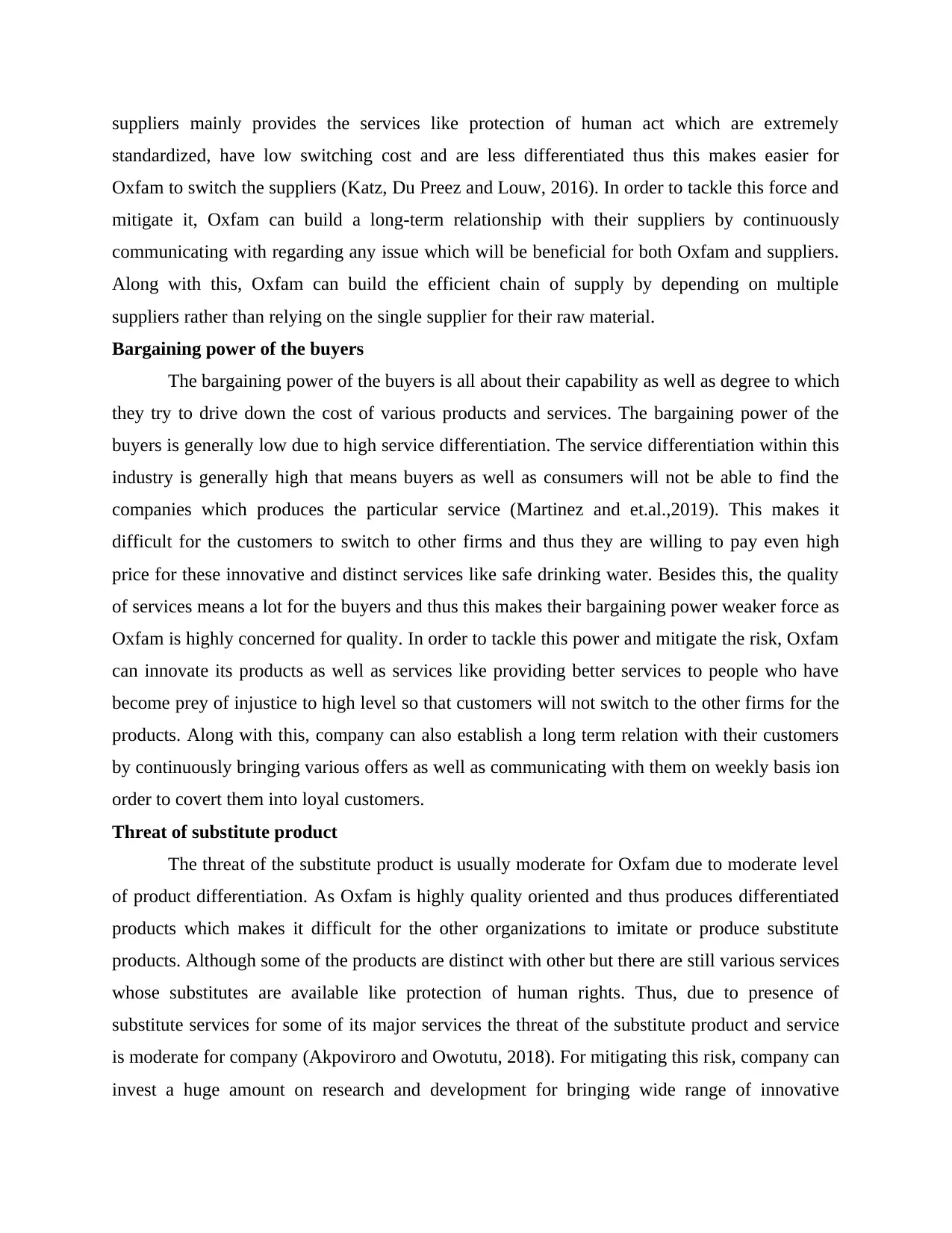
suppliers mainly provides the services like protection of human act which are extremely
standardized, have low switching cost and are less differentiated thus this makes easier for
Oxfam to switch the suppliers (Katz, Du Preez and Louw, 2016). In order to tackle this force and
mitigate it, Oxfam can build a long-term relationship with their suppliers by continuously
communicating with regarding any issue which will be beneficial for both Oxfam and suppliers.
Along with this, Oxfam can build the efficient chain of supply by depending on multiple
suppliers rather than relying on the single supplier for their raw material.
Bargaining power of the buyers
The bargaining power of the buyers is all about their capability as well as degree to which
they try to drive down the cost of various products and services. The bargaining power of the
buyers is generally low due to high service differentiation. The service differentiation within this
industry is generally high that means buyers as well as consumers will not be able to find the
companies which produces the particular service (Martinez and et.al.,2019). This makes it
difficult for the customers to switch to other firms and thus they are willing to pay even high
price for these innovative and distinct services like safe drinking water. Besides this, the quality
of services means a lot for the buyers and thus this makes their bargaining power weaker force as
Oxfam is highly concerned for quality. In order to tackle this power and mitigate the risk, Oxfam
can innovate its products as well as services like providing better services to people who have
become prey of injustice to high level so that customers will not switch to the other firms for the
products. Along with this, company can also establish a long term relation with their customers
by continuously bringing various offers as well as communicating with them on weekly basis ion
order to covert them into loyal customers.
Threat of substitute product
The threat of the substitute product is usually moderate for Oxfam due to moderate level
of product differentiation. As Oxfam is highly quality oriented and thus produces differentiated
products which makes it difficult for the other organizations to imitate or produce substitute
products. Although some of the products are distinct with other but there are still various services
whose substitutes are available like protection of human rights. Thus, due to presence of
substitute services for some of its major services the threat of the substitute product and service
is moderate for company (Akpoviroro and Owotutu, 2018). For mitigating this risk, company can
invest a huge amount on research and development for bringing wide range of innovative
standardized, have low switching cost and are less differentiated thus this makes easier for
Oxfam to switch the suppliers (Katz, Du Preez and Louw, 2016). In order to tackle this force and
mitigate it, Oxfam can build a long-term relationship with their suppliers by continuously
communicating with regarding any issue which will be beneficial for both Oxfam and suppliers.
Along with this, Oxfam can build the efficient chain of supply by depending on multiple
suppliers rather than relying on the single supplier for their raw material.
Bargaining power of the buyers
The bargaining power of the buyers is all about their capability as well as degree to which
they try to drive down the cost of various products and services. The bargaining power of the
buyers is generally low due to high service differentiation. The service differentiation within this
industry is generally high that means buyers as well as consumers will not be able to find the
companies which produces the particular service (Martinez and et.al.,2019). This makes it
difficult for the customers to switch to other firms and thus they are willing to pay even high
price for these innovative and distinct services like safe drinking water. Besides this, the quality
of services means a lot for the buyers and thus this makes their bargaining power weaker force as
Oxfam is highly concerned for quality. In order to tackle this power and mitigate the risk, Oxfam
can innovate its products as well as services like providing better services to people who have
become prey of injustice to high level so that customers will not switch to the other firms for the
products. Along with this, company can also establish a long term relation with their customers
by continuously bringing various offers as well as communicating with them on weekly basis ion
order to covert them into loyal customers.
Threat of substitute product
The threat of the substitute product is usually moderate for Oxfam due to moderate level
of product differentiation. As Oxfam is highly quality oriented and thus produces differentiated
products which makes it difficult for the other organizations to imitate or produce substitute
products. Although some of the products are distinct with other but there are still various services
whose substitutes are available like protection of human rights. Thus, due to presence of
substitute services for some of its major services the threat of the substitute product and service
is moderate for company (Akpoviroro and Owotutu, 2018). For mitigating this risk, company can
invest a huge amount on research and development for bringing wide range of innovative
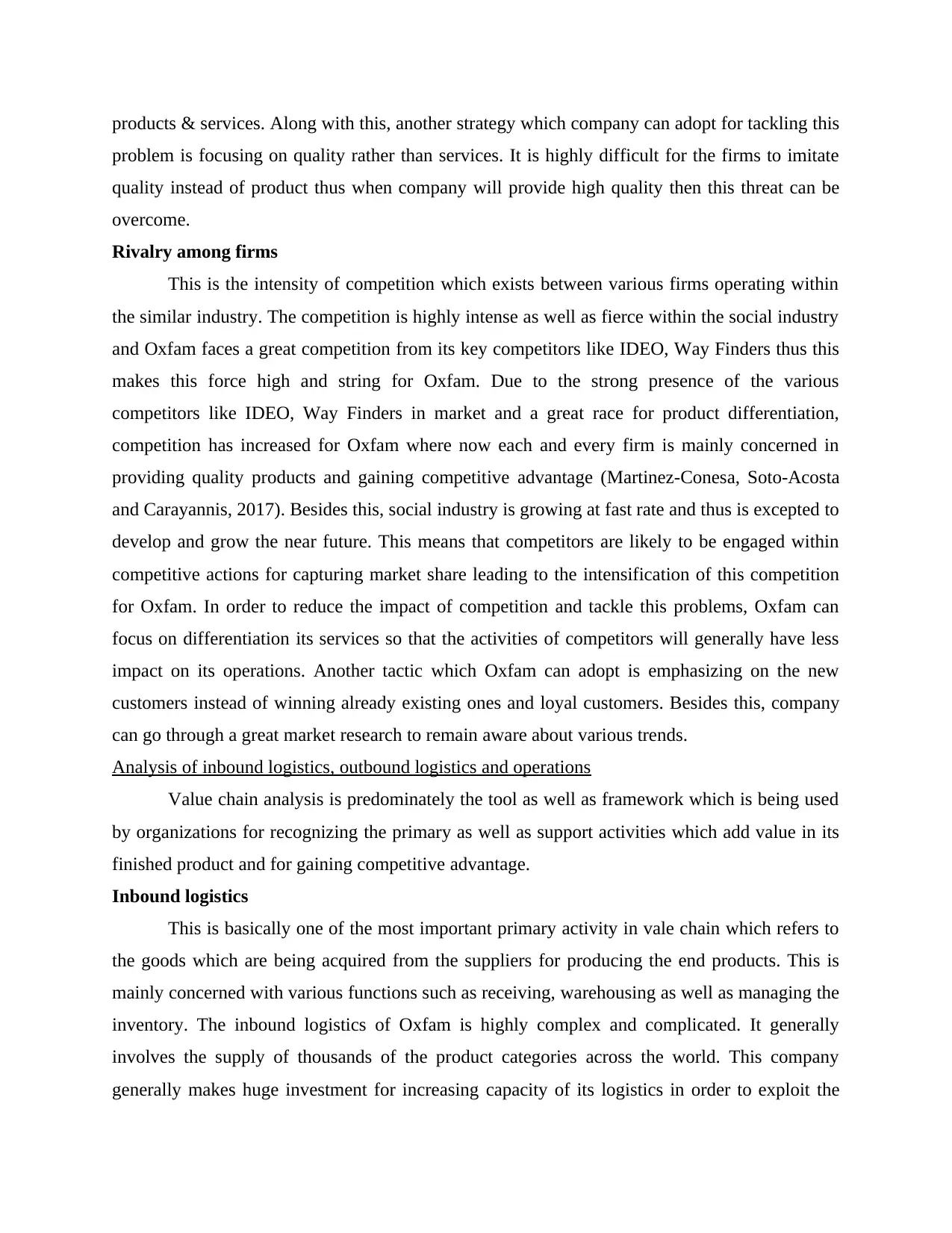
products & services. Along with this, another strategy which company can adopt for tackling this
problem is focusing on quality rather than services. It is highly difficult for the firms to imitate
quality instead of product thus when company will provide high quality then this threat can be
overcome.
Rivalry among firms
This is the intensity of competition which exists between various firms operating within
the similar industry. The competition is highly intense as well as fierce within the social industry
and Oxfam faces a great competition from its key competitors like IDEO, Way Finders thus this
makes this force high and string for Oxfam. Due to the strong presence of the various
competitors like IDEO, Way Finders in market and a great race for product differentiation,
competition has increased for Oxfam where now each and every firm is mainly concerned in
providing quality products and gaining competitive advantage (Martinez-Conesa, Soto-Acosta
and Carayannis, 2017). Besides this, social industry is growing at fast rate and thus is excepted to
develop and grow the near future. This means that competitors are likely to be engaged within
competitive actions for capturing market share leading to the intensification of this competition
for Oxfam. In order to reduce the impact of competition and tackle this problems, Oxfam can
focus on differentiation its services so that the activities of competitors will generally have less
impact on its operations. Another tactic which Oxfam can adopt is emphasizing on the new
customers instead of winning already existing ones and loyal customers. Besides this, company
can go through a great market research to remain aware about various trends.
Analysis of inbound logistics, outbound logistics and operations
Value chain analysis is predominately the tool as well as framework which is being used
by organizations for recognizing the primary as well as support activities which add value in its
finished product and for gaining competitive advantage.
Inbound logistics
This is basically one of the most important primary activity in vale chain which refers to
the goods which are being acquired from the suppliers for producing the end products. This is
mainly concerned with various functions such as receiving, warehousing as well as managing the
inventory. The inbound logistics of Oxfam is highly complex and complicated. It generally
involves the supply of thousands of the product categories across the world. This company
generally makes huge investment for increasing capacity of its logistics in order to exploit the
problem is focusing on quality rather than services. It is highly difficult for the firms to imitate
quality instead of product thus when company will provide high quality then this threat can be
overcome.
Rivalry among firms
This is the intensity of competition which exists between various firms operating within
the similar industry. The competition is highly intense as well as fierce within the social industry
and Oxfam faces a great competition from its key competitors like IDEO, Way Finders thus this
makes this force high and string for Oxfam. Due to the strong presence of the various
competitors like IDEO, Way Finders in market and a great race for product differentiation,
competition has increased for Oxfam where now each and every firm is mainly concerned in
providing quality products and gaining competitive advantage (Martinez-Conesa, Soto-Acosta
and Carayannis, 2017). Besides this, social industry is growing at fast rate and thus is excepted to
develop and grow the near future. This means that competitors are likely to be engaged within
competitive actions for capturing market share leading to the intensification of this competition
for Oxfam. In order to reduce the impact of competition and tackle this problems, Oxfam can
focus on differentiation its services so that the activities of competitors will generally have less
impact on its operations. Another tactic which Oxfam can adopt is emphasizing on the new
customers instead of winning already existing ones and loyal customers. Besides this, company
can go through a great market research to remain aware about various trends.
Analysis of inbound logistics, outbound logistics and operations
Value chain analysis is predominately the tool as well as framework which is being used
by organizations for recognizing the primary as well as support activities which add value in its
finished product and for gaining competitive advantage.
Inbound logistics
This is basically one of the most important primary activity in vale chain which refers to
the goods which are being acquired from the suppliers for producing the end products. This is
mainly concerned with various functions such as receiving, warehousing as well as managing the
inventory. The inbound logistics of Oxfam is highly complex and complicated. It generally
involves the supply of thousands of the product categories across the world. This company
generally makes huge investment for increasing capacity of its logistics in order to exploit the
⊘ This is a preview!⊘
Do you want full access?
Subscribe today to unlock all pages.

Trusted by 1+ million students worldwide
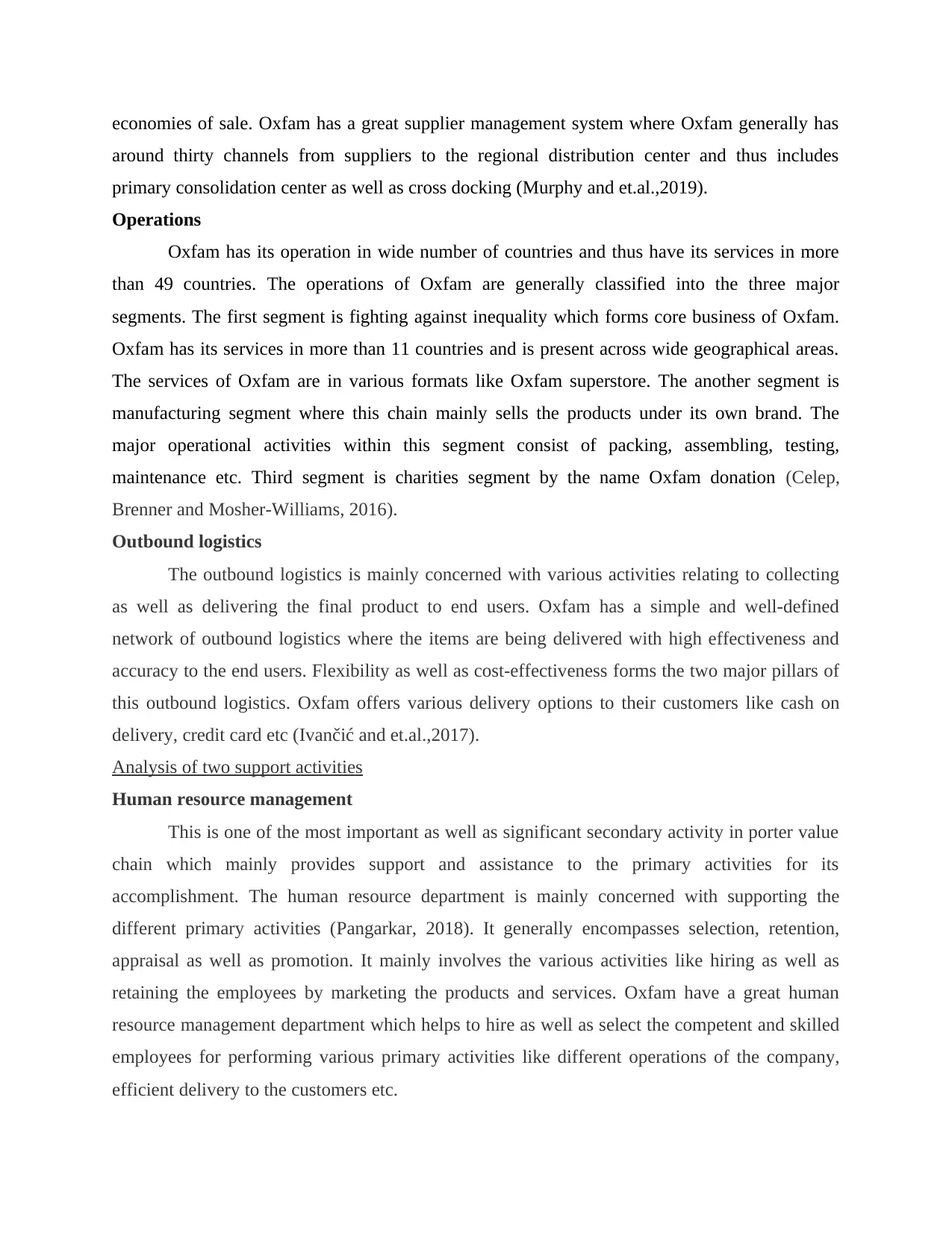
economies of sale. Oxfam has a great supplier management system where Oxfam generally has
around thirty channels from suppliers to the regional distribution center and thus includes
primary consolidation center as well as cross docking (Murphy and et.al.,2019).
Operations
Oxfam has its operation in wide number of countries and thus have its services in more
than 49 countries. The operations of Oxfam are generally classified into the three major
segments. The first segment is fighting against inequality which forms core business of Oxfam.
Oxfam has its services in more than 11 countries and is present across wide geographical areas.
The services of Oxfam are in various formats like Oxfam superstore. The another segment is
manufacturing segment where this chain mainly sells the products under its own brand. The
major operational activities within this segment consist of packing, assembling, testing,
maintenance etc. Third segment is charities segment by the name Oxfam donation (Celep,
Brenner and Mosher-Williams, 2016).
Outbound logistics
The outbound logistics is mainly concerned with various activities relating to collecting
as well as delivering the final product to end users. Oxfam has a simple and well-defined
network of outbound logistics where the items are being delivered with high effectiveness and
accuracy to the end users. Flexibility as well as cost-effectiveness forms the two major pillars of
this outbound logistics. Oxfam offers various delivery options to their customers like cash on
delivery, credit card etc (Ivančić and et.al.,2017).
Analysis of two support activities
Human resource management
This is one of the most important as well as significant secondary activity in porter value
chain which mainly provides support and assistance to the primary activities for its
accomplishment. The human resource department is mainly concerned with supporting the
different primary activities (Pangarkar, 2018). It generally encompasses selection, retention,
appraisal as well as promotion. It mainly involves the various activities like hiring as well as
retaining the employees by marketing the products and services. Oxfam have a great human
resource management department which helps to hire as well as select the competent and skilled
employees for performing various primary activities like different operations of the company,
efficient delivery to the customers etc.
around thirty channels from suppliers to the regional distribution center and thus includes
primary consolidation center as well as cross docking (Murphy and et.al.,2019).
Operations
Oxfam has its operation in wide number of countries and thus have its services in more
than 49 countries. The operations of Oxfam are generally classified into the three major
segments. The first segment is fighting against inequality which forms core business of Oxfam.
Oxfam has its services in more than 11 countries and is present across wide geographical areas.
The services of Oxfam are in various formats like Oxfam superstore. The another segment is
manufacturing segment where this chain mainly sells the products under its own brand. The
major operational activities within this segment consist of packing, assembling, testing,
maintenance etc. Third segment is charities segment by the name Oxfam donation (Celep,
Brenner and Mosher-Williams, 2016).
Outbound logistics
The outbound logistics is mainly concerned with various activities relating to collecting
as well as delivering the final product to end users. Oxfam has a simple and well-defined
network of outbound logistics where the items are being delivered with high effectiveness and
accuracy to the end users. Flexibility as well as cost-effectiveness forms the two major pillars of
this outbound logistics. Oxfam offers various delivery options to their customers like cash on
delivery, credit card etc (Ivančić and et.al.,2017).
Analysis of two support activities
Human resource management
This is one of the most important as well as significant secondary activity in porter value
chain which mainly provides support and assistance to the primary activities for its
accomplishment. The human resource department is mainly concerned with supporting the
different primary activities (Pangarkar, 2018). It generally encompasses selection, retention,
appraisal as well as promotion. It mainly involves the various activities like hiring as well as
retaining the employees by marketing the products and services. Oxfam have a great human
resource management department which helps to hire as well as select the competent and skilled
employees for performing various primary activities like different operations of the company,
efficient delivery to the customers etc.
Paraphrase This Document
Need a fresh take? Get an instant paraphrase of this document with our AI Paraphraser
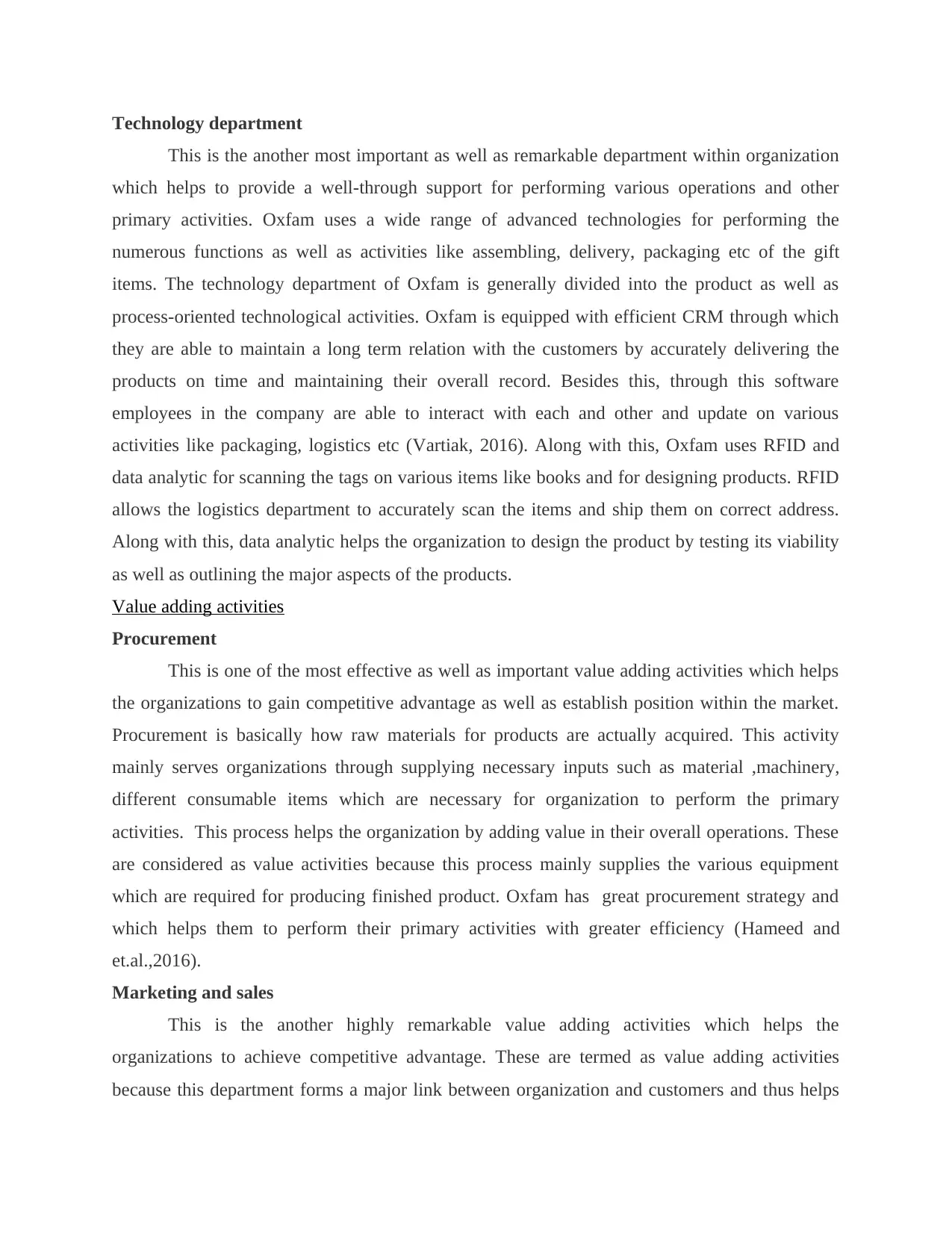
Technology department
This is the another most important as well as remarkable department within organization
which helps to provide a well-through support for performing various operations and other
primary activities. Oxfam uses a wide range of advanced technologies for performing the
numerous functions as well as activities like assembling, delivery, packaging etc of the gift
items. The technology department of Oxfam is generally divided into the product as well as
process-oriented technological activities. Oxfam is equipped with efficient CRM through which
they are able to maintain a long term relation with the customers by accurately delivering the
products on time and maintaining their overall record. Besides this, through this software
employees in the company are able to interact with each and other and update on various
activities like packaging, logistics etc (Vartiak, 2016). Along with this, Oxfam uses RFID and
data analytic for scanning the tags on various items like books and for designing products. RFID
allows the logistics department to accurately scan the items and ship them on correct address.
Along with this, data analytic helps the organization to design the product by testing its viability
as well as outlining the major aspects of the products.
Value adding activities
Procurement
This is one of the most effective as well as important value adding activities which helps
the organizations to gain competitive advantage as well as establish position within the market.
Procurement is basically how raw materials for products are actually acquired. This activity
mainly serves organizations through supplying necessary inputs such as material ,machinery,
different consumable items which are necessary for organization to perform the primary
activities. This process helps the organization by adding value in their overall operations. These
are considered as value activities because this process mainly supplies the various equipment
which are required for producing finished product. Oxfam has great procurement strategy and
which helps them to perform their primary activities with greater efficiency (Hameed and
et.al.,2016).
Marketing and sales
This is the another highly remarkable value adding activities which helps the
organizations to achieve competitive advantage. These are termed as value adding activities
because this department forms a major link between organization and customers and thus helps
This is the another most important as well as remarkable department within organization
which helps to provide a well-through support for performing various operations and other
primary activities. Oxfam uses a wide range of advanced technologies for performing the
numerous functions as well as activities like assembling, delivery, packaging etc of the gift
items. The technology department of Oxfam is generally divided into the product as well as
process-oriented technological activities. Oxfam is equipped with efficient CRM through which
they are able to maintain a long term relation with the customers by accurately delivering the
products on time and maintaining their overall record. Besides this, through this software
employees in the company are able to interact with each and other and update on various
activities like packaging, logistics etc (Vartiak, 2016). Along with this, Oxfam uses RFID and
data analytic for scanning the tags on various items like books and for designing products. RFID
allows the logistics department to accurately scan the items and ship them on correct address.
Along with this, data analytic helps the organization to design the product by testing its viability
as well as outlining the major aspects of the products.
Value adding activities
Procurement
This is one of the most effective as well as important value adding activities which helps
the organizations to gain competitive advantage as well as establish position within the market.
Procurement is basically how raw materials for products are actually acquired. This activity
mainly serves organizations through supplying necessary inputs such as material ,machinery,
different consumable items which are necessary for organization to perform the primary
activities. This process helps the organization by adding value in their overall operations. These
are considered as value activities because this process mainly supplies the various equipment
which are required for producing finished product. Oxfam has great procurement strategy and
which helps them to perform their primary activities with greater efficiency (Hameed and
et.al.,2016).
Marketing and sales
This is the another highly remarkable value adding activities which helps the
organizations to achieve competitive advantage. These are termed as value adding activities
because this department forms a major link between organization and customers and thus helps

to take the brand message to wider audience. Oxfam has generally two departments marketing
and sales and each department has more than 300 employees across the world. These two
department basically helps the company to persuade customers for their products and services
and helps to build a great customer base. This department makes use of both online as well as
offline channels for attracting the customers and increasing their engagement. The main aim of
this department is to increase the sales of Oxfam by providing a great quality services and
products to the customers (Neneh, 2016).
Infrastructure
Infrastructure generally refers to the structure as well as management of the organization
along with its planning, accounting and quality-control mechanism. This is basically the
management system that provides and offers various services to the organization and
encompasses planning, finance, legal affairs etc. These are considered as value adding activities
because without a proper planning and other tasks like quality control, an organization cannot
count on themselves and will not be able to provide quality services to customers. The
infrastructure of Oxfam is such that it helps the company to effective assess the various market
trends and enables the company to add vale in each and every aspect by managing various legal
affairs, having efficient quality control etc (Hameed and et.al.,2016). Infrastructure of Oxfam is
generally divided into various departments like legal department, accounting department etc
which through cross-functional communication helps to produce quality finished products.
and sales and each department has more than 300 employees across the world. These two
department basically helps the company to persuade customers for their products and services
and helps to build a great customer base. This department makes use of both online as well as
offline channels for attracting the customers and increasing their engagement. The main aim of
this department is to increase the sales of Oxfam by providing a great quality services and
products to the customers (Neneh, 2016).
Infrastructure
Infrastructure generally refers to the structure as well as management of the organization
along with its planning, accounting and quality-control mechanism. This is basically the
management system that provides and offers various services to the organization and
encompasses planning, finance, legal affairs etc. These are considered as value adding activities
because without a proper planning and other tasks like quality control, an organization cannot
count on themselves and will not be able to provide quality services to customers. The
infrastructure of Oxfam is such that it helps the company to effective assess the various market
trends and enables the company to add vale in each and every aspect by managing various legal
affairs, having efficient quality control etc (Hameed and et.al.,2016). Infrastructure of Oxfam is
generally divided into various departments like legal department, accounting department etc
which through cross-functional communication helps to produce quality finished products.
⊘ This is a preview!⊘
Do you want full access?
Subscribe today to unlock all pages.

Trusted by 1+ million students worldwide
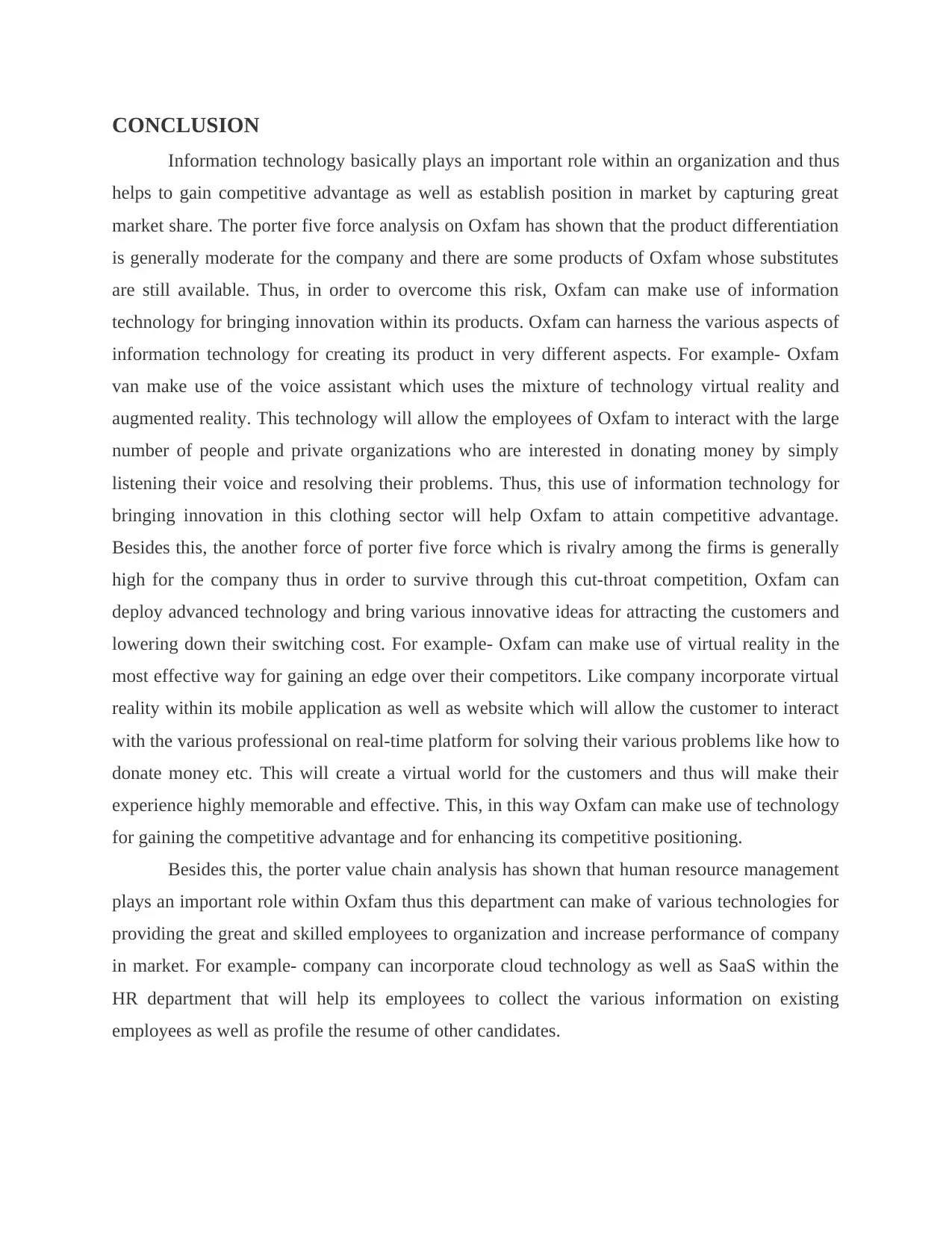
CONCLUSION
Information technology basically plays an important role within an organization and thus
helps to gain competitive advantage as well as establish position in market by capturing great
market share. The porter five force analysis on Oxfam has shown that the product differentiation
is generally moderate for the company and there are some products of Oxfam whose substitutes
are still available. Thus, in order to overcome this risk, Oxfam can make use of information
technology for bringing innovation within its products. Oxfam can harness the various aspects of
information technology for creating its product in very different aspects. For example- Oxfam
van make use of the voice assistant which uses the mixture of technology virtual reality and
augmented reality. This technology will allow the employees of Oxfam to interact with the large
number of people and private organizations who are interested in donating money by simply
listening their voice and resolving their problems. Thus, this use of information technology for
bringing innovation in this clothing sector will help Oxfam to attain competitive advantage.
Besides this, the another force of porter five force which is rivalry among the firms is generally
high for the company thus in order to survive through this cut-throat competition, Oxfam can
deploy advanced technology and bring various innovative ideas for attracting the customers and
lowering down their switching cost. For example- Oxfam can make use of virtual reality in the
most effective way for gaining an edge over their competitors. Like company incorporate virtual
reality within its mobile application as well as website which will allow the customer to interact
with the various professional on real-time platform for solving their various problems like how to
donate money etc. This will create a virtual world for the customers and thus will make their
experience highly memorable and effective. This, in this way Oxfam can make use of technology
for gaining the competitive advantage and for enhancing its competitive positioning.
Besides this, the porter value chain analysis has shown that human resource management
plays an important role within Oxfam thus this department can make of various technologies for
providing the great and skilled employees to organization and increase performance of company
in market. For example- company can incorporate cloud technology as well as SaaS within the
HR department that will help its employees to collect the various information on existing
employees as well as profile the resume of other candidates.
Information technology basically plays an important role within an organization and thus
helps to gain competitive advantage as well as establish position in market by capturing great
market share. The porter five force analysis on Oxfam has shown that the product differentiation
is generally moderate for the company and there are some products of Oxfam whose substitutes
are still available. Thus, in order to overcome this risk, Oxfam can make use of information
technology for bringing innovation within its products. Oxfam can harness the various aspects of
information technology for creating its product in very different aspects. For example- Oxfam
van make use of the voice assistant which uses the mixture of technology virtual reality and
augmented reality. This technology will allow the employees of Oxfam to interact with the large
number of people and private organizations who are interested in donating money by simply
listening their voice and resolving their problems. Thus, this use of information technology for
bringing innovation in this clothing sector will help Oxfam to attain competitive advantage.
Besides this, the another force of porter five force which is rivalry among the firms is generally
high for the company thus in order to survive through this cut-throat competition, Oxfam can
deploy advanced technology and bring various innovative ideas for attracting the customers and
lowering down their switching cost. For example- Oxfam can make use of virtual reality in the
most effective way for gaining an edge over their competitors. Like company incorporate virtual
reality within its mobile application as well as website which will allow the customer to interact
with the various professional on real-time platform for solving their various problems like how to
donate money etc. This will create a virtual world for the customers and thus will make their
experience highly memorable and effective. This, in this way Oxfam can make use of technology
for gaining the competitive advantage and for enhancing its competitive positioning.
Besides this, the porter value chain analysis has shown that human resource management
plays an important role within Oxfam thus this department can make of various technologies for
providing the great and skilled employees to organization and increase performance of company
in market. For example- company can incorporate cloud technology as well as SaaS within the
HR department that will help its employees to collect the various information on existing
employees as well as profile the resume of other candidates.
Paraphrase This Document
Need a fresh take? Get an instant paraphrase of this document with our AI Paraphraser
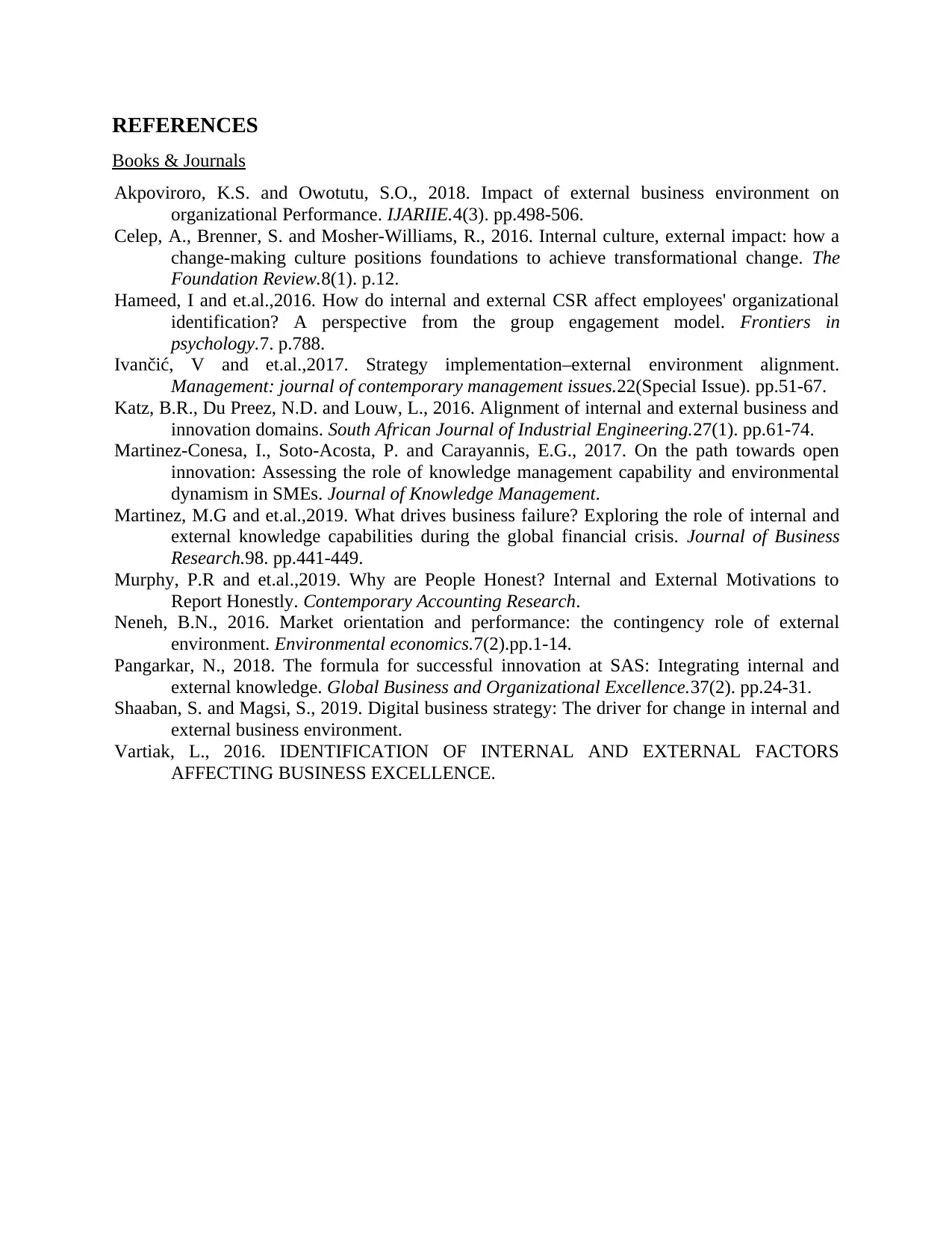
REFERENCES
Books & Journals
Akpoviroro, K.S. and Owotutu, S.O., 2018. Impact of external business environment on
organizational Performance. IJARIIE.4(3). pp.498-506.
Celep, A., Brenner, S. and Mosher-Williams, R., 2016. Internal culture, external impact: how a
change-making culture positions foundations to achieve transformational change. The
Foundation Review.8(1). p.12.
Hameed, I and et.al.,2016. How do internal and external CSR affect employees' organizational
identification? A perspective from the group engagement model. Frontiers in
psychology.7. p.788.
Ivančić, V and et.al.,2017. Strategy implementation–external environment alignment.
Management: journal of contemporary management issues.22(Special Issue). pp.51-67.
Katz, B.R., Du Preez, N.D. and Louw, L., 2016. Alignment of internal and external business and
innovation domains. South African Journal of Industrial Engineering.27(1). pp.61-74.
Martinez-Conesa, I., Soto-Acosta, P. and Carayannis, E.G., 2017. On the path towards open
innovation: Assessing the role of knowledge management capability and environmental
dynamism in SMEs. Journal of Knowledge Management.
Martinez, M.G and et.al.,2019. What drives business failure? Exploring the role of internal and
external knowledge capabilities during the global financial crisis. Journal of Business
Research.98. pp.441-449.
Murphy, P.R and et.al.,2019. Why are People Honest? Internal and External Motivations to
Report Honestly. Contemporary Accounting Research.
Neneh, B.N., 2016. Market orientation and performance: the contingency role of external
environment. Environmental economics.7(2).pp.1-14.
Pangarkar, N., 2018. The formula for successful innovation at SAS: Integrating internal and
external knowledge. Global Business and Organizational Excellence.37(2). pp.24-31.
Shaaban, S. and Magsi, S., 2019. Digital business strategy: The driver for change in internal and
external business environment.
Vartiak, L., 2016. IDENTIFICATION OF INTERNAL AND EXTERNAL FACTORS
AFFECTING BUSINESS EXCELLENCE.
Books & Journals
Akpoviroro, K.S. and Owotutu, S.O., 2018. Impact of external business environment on
organizational Performance. IJARIIE.4(3). pp.498-506.
Celep, A., Brenner, S. and Mosher-Williams, R., 2016. Internal culture, external impact: how a
change-making culture positions foundations to achieve transformational change. The
Foundation Review.8(1). p.12.
Hameed, I and et.al.,2016. How do internal and external CSR affect employees' organizational
identification? A perspective from the group engagement model. Frontiers in
psychology.7. p.788.
Ivančić, V and et.al.,2017. Strategy implementation–external environment alignment.
Management: journal of contemporary management issues.22(Special Issue). pp.51-67.
Katz, B.R., Du Preez, N.D. and Louw, L., 2016. Alignment of internal and external business and
innovation domains. South African Journal of Industrial Engineering.27(1). pp.61-74.
Martinez-Conesa, I., Soto-Acosta, P. and Carayannis, E.G., 2017. On the path towards open
innovation: Assessing the role of knowledge management capability and environmental
dynamism in SMEs. Journal of Knowledge Management.
Martinez, M.G and et.al.,2019. What drives business failure? Exploring the role of internal and
external knowledge capabilities during the global financial crisis. Journal of Business
Research.98. pp.441-449.
Murphy, P.R and et.al.,2019. Why are People Honest? Internal and External Motivations to
Report Honestly. Contemporary Accounting Research.
Neneh, B.N., 2016. Market orientation and performance: the contingency role of external
environment. Environmental economics.7(2).pp.1-14.
Pangarkar, N., 2018. The formula for successful innovation at SAS: Integrating internal and
external knowledge. Global Business and Organizational Excellence.37(2). pp.24-31.
Shaaban, S. and Magsi, S., 2019. Digital business strategy: The driver for change in internal and
external business environment.
Vartiak, L., 2016. IDENTIFICATION OF INTERNAL AND EXTERNAL FACTORS
AFFECTING BUSINESS EXCELLENCE.

⊘ This is a preview!⊘
Do you want full access?
Subscribe today to unlock all pages.

Trusted by 1+ million students worldwide
1 out of 12
Related Documents
Your All-in-One AI-Powered Toolkit for Academic Success.
+13062052269
info@desklib.com
Available 24*7 on WhatsApp / Email
![[object Object]](/_next/static/media/star-bottom.7253800d.svg)
Unlock your academic potential
Copyright © 2020–2025 A2Z Services. All Rights Reserved. Developed and managed by ZUCOL.





